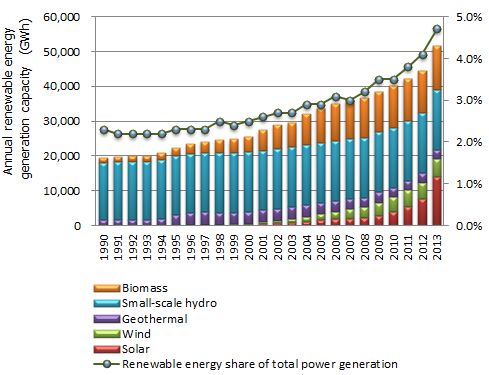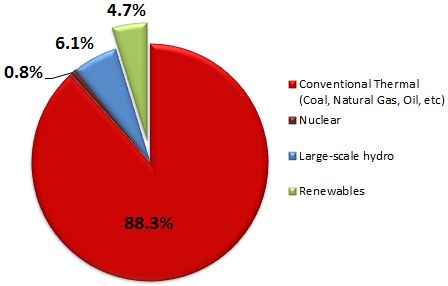May 25, 2015
Current Status of Renewable Energy in Japan (2015)
Keywords: Renewable Energy
Japan's feed-in-tariff (FIT) scheme for utilities to purchase electricity from renewable energy sources has made some outstanding achievements since its start more than two years ago. But it is now facing a major turning point, as power utilities have stopped responding to new applications for grid connection from renewable energy producers.
We at Japan for Sustainability (JFS) have continued to post the latest status of renewable energy in Japan through our newsletters and articles. In December 2014, we provided information on the current status and challenges in Japan in our newsletter, titled "Achievements of Japan's FIT Scheme and Challenges for Power System Reform."
JFS Newsletters:
Japan's First Floating Offshore Wind Power Project Making Progress, Addressing Challenges (February 2014)
Creating a Dialogue-Oriented City -- Thinking about Energy and the Future of Kashiwazaki City (May 2014)
Japan Celebrates One Year Completely Nuclear-free: Second Phase of Energy [R]evolution Begins (October 2014)
JFS News Articles:
Community and Locally-led Renewable Energy Project Highlighted in Renewables Japan Status Report 2014
Japan's Power Utilities to Suspend Responding to Clean Energy Applications
Today, we updated the data on the "Current Status on Renewable Energy in Japan" webpage to fiscal 2013 data, in which we inform you on the current status of domestic renewable energy.
The following table shows estimated domestic energy generation by each renewable source and its percentage share of total power generation* in Japan, and the graph shows trends in renewable energy generation capacities.
*Total Power Generation in Japan: renewable energy generation (estimated in the "Renewables Japan Status" report) added to power generation, including major electric power utilities, other electric power producers, and in-house power generation (based on "Energy Data and Modeling Center [EDMC)] data" and the "Statistical Handbook of the Japan Electric Association").
| Type of Renewable Energy | Estimated Annual Power Generation Capacity(GWh) | Share of Total (%) |
| Solar photovoltaic (PV) | 13,981 | 1.27% |
| Wind | 5,201 | 0.47% |
| Geothermal | 2,596 | 0.24% |
| Small-scale hydropower | 17,422 | 1.58% |
| Biomass | 12,524 | 1.14% |
| Total | 51,724 | 4.7% |

Trends in annual renewable energy generation
The above figures were calculated based on the following:
- Photovoltaic: For fiscal 2013, household generated power (50% assumed to be consumed by household) is added to figures from Electric Power Statistics. From fiscal 2012, FIT facilities' startup capacities are used. Until fiscal 2011, the amount was calculated based on a 12% utilization rate of cumulative capacity derived from the Japan Photovoltaic Energy Association's (JPEA) domestic shipments data.
- Wind: From fiscal 2012, figures from the "Statistical Handbook" or Electric Power Statistics were used. From 2003 to 2011, the amount is power supplied under the Renewable Portfolio Standard (RPS). Before 2002, the amount is estimated based on a 20% utilization rate of total capacity.
- Geothermal: From fiscal 2012, figures from the "Statistical Handbook" were used. Before fiscal 2011, actual data from the "Current Status and Trend in Geothermal Power" published by the Thermal and Nuclear Power Engineers Society were used.
- Small-ScaleHydropower: Calculated based on a 61% utilization rate of total capacity of facilities listed in the "Hydropower Stations Database" published by the Japan Electric Power Civil Engineering Association. Included power stations are conduit-type RPS facilities that are either run-of-river type or with a reservoir with maximum generation capacity of up to 10,000 kilowatts.
- Biomass: From fiscal 2012, figures are FIT facility startup capacities. Up to fiscal 2011, calculated based on a 70% utilization rate of total capacity, assuming that 60% of fuel is biomass. Included power stations were RPS facilities with a biomass ratio of about 60 or greater.
The graph below shows overall domestic energy generation in FY2013, by source.

Energy generation, by source (2013)
Produced in collaboration with the Institute for Sustainable Energy Policies (ISEP):
http://www.isep.or.jp/en/
Reference:
Renewables Japan Status Report 2014
Related
"JFS Newsletter"
- 'Yumekaze' Wind Turbine Project Connects Metro Consumers and Regional Producers: Seikatsu Club Consumers' Co-operative
- Shaping Japan's Energy toward 2050 Participating in the Round Table for Studying Energy Situations
- Nishiawakura's Initiative for 100% Energy Self-Sufficiency, and a Municipal ICO Scheme
- Actions Toward 100% Renewable Energy in Japan
- Sustainable Community Building in Shimokawa: Recycling-Oriented Forest Management Enabling Permanent Use of Forest Resources
Related
"Popular Articles"
- Current Status of Renewable Energy in Japan (2015)
- Offshore Wind Farm Withstands Great East Japan Earthquake and Tsunami
- Current Status of Renewable Energy in Japan (2014)
- Geothermal Power: Japan Has World's Third Largest Geothermal Reserves, 60 Percent of Which Can Be Developed
- Tokyo Plans to Increase Renewable Energy Ratio to 20% by 2024


